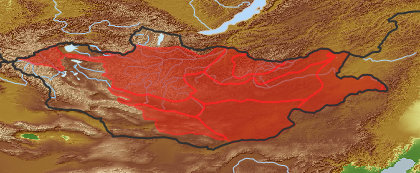| Class: | angiosperms |
| Order: | Sapindales |
| Family: | Rutaceae |
| Name acc. to: | APGII |
| Herbar: | list records   |
| Description: | Carpels 4 or 5, each with 2-many ovules; stigma 1 or as many as carpels. |
| Tax. Comments: | Classification withion the family is far from clear (see Heywood 2007). |
| Comments: | A variable family, most species are characterised by aromatic oil glands. |
| Link to Flora of China: | http://www.efloras.org/florataxon.aspx?flora_id=2&taxon_id=10781 |
| open map in a new window |  |
| genus: 2 |
| species: 2 |
| Habit (i)general appearance of a plant | |
| Growth form: (i)Herb, shrub, tree or climber. | herb (i)Herbaceous, erect plant, up to 2m high, mostly with a leafy shoot; if perennial, shoots die to the ground each season, shoots are not woody
example: Artemisia pectinata 
perennial (i)Living for several to many years, as opposed to annual and biennial
|
| Parasite status: (i)Is the plant a half- or full parasite? | no parasite/saprophyte (i)Plant fully autonomous, leaves with chlorophyll
example: Most plants, Ranunculus
|
| Water or terrestrial plant: (i)Where do the plants grow? | terrestrial (i)Plant grows on dry land
example: Orostachys spinosa
|
| Leaf (i)expanded, usually photosynthetic organ of a plant (including phylloclades) | |
| Petiole: (i)Leaf divided into stalk (petiole) and blade. | with (i)Leaves with petiole (stalk) 
|
| Stipule: (i)Leaflets at the base of the petiole, these are smaller and of different shape. | none (i)Without stipules
example: Euphorbia, Ericaceae s.l.
|
| Leaf veination: (i)Arrangement of the main veins of a leaf. | pinnate (i)One main vein, several side veins, sometimes inconspicuous
example: Cicerbita   
|
| Flower (i)reproductive portion of the plant, consisting of sepals, petals, stamens, and pistils | |
| Flower appearance and pollination: (i)General appearance of the flower. | attractive, animal-pollinated (i)attractive and coloured flowers, mostly large, attracting surely animals
example: Trollius, Rosa, Chamaerhodos
|
| Perianth arrangement: (i)Attention: in some plants, flowers may be dimorphic in different ways (dioecious or gynodioecious). If flowers vary, record the characters of the most showy flowers. | double, different (i)Two types of perianth leaves, differently coloured (sepals: outer periant leaves, usually greenish, and petals: inner perianth leaves, usually coloured)
example: Parnassia  
|
| Sepal number: (i)Number of sepal leaves (outer perianth leaves, calyx leaves, mostly greenish). Attention, this character applies only for flowers separated in sepals and petals, thus excluding most monocots. Be aware of the bracts (involucral leaves) of Asteraceae flowerheads, do not qualify these as sepals! Be also aware in Rosaceae is often an epicalyx developed, in this case count all parts. | 5 (i)
example: Polemonium
|
| Petal / Tepal number: (i)Number of petal leaves (inner perianth leaves, usually coloured). | 5 (i)
example: Potentilla
|
| Petal / Tepal fusion: (i)To which degree are the petal leaves connected? Petals sympetalous. | free (i)all petal leaves separate from each other
example: Anthriscus
|
| Spur: (i)A hollow, slender, sac-like appendage of the perianth leaves, storing nectar. | no spur (i)Flower without appendage
example: Peganum
|
| Stamen number: (i)Attention: We ask for the reproductive organs of the flower dispersing pollen. Count only fully fertile stamens, not staminodia (e.g. Parnassia). | 10 (i)
example: Silene
|
| Stamen fusion: (i)To which degree are the stamens fused? Attention: Whereas the pollen sacs itself are often free., their stalks (filaments) may be fused. Here, we count them as fused if they are together over at least one thirth of their length. | free (i)Stamens with separate bases
example: Malus
|
| Style number: (i)Portion of the pistil connecting the stigma to the ovary. | 1
|
| Ovary position: (i)For entirely or partly fused carpels, describe their position in relation to the insertion point of perianth leaves (best done by doing a longitudinal section of a flower). | superior (hypogynous) (i)Base of carpels attached above insertion point of perianth leaves, carpels free or fused
example: Delphinium, Anemone  
|
| Sex: (i)Distribution of male and female organs among flowers, only most commonly cases. | bisexual, hermaphrodite (i)All or nearly all flowers of a plant with male and female parts
example: Haplophyllum, Chenopodium
|
| Inflorescence (i)flowering part of a plant, describes the arrangement of the flowers on the flowering axis | |
| Inflorescence: (i)Structure of the inflorescence. | Flowers in inflorescence (i)No solitary flowers
|
| Appearance: (i)Outer look of the inflorescence. | terminal (i)Inflorescence is the highest point of the plant and may consist of a single flower only
example: Cypripedium, Rhaponticum, Ligularia sibirica, Echinops
|
| Fruit (i)the seed bearing organ, with or without adnate parts; a ripened ovary and any other structures which are attached and ripen with it. Aggregate fruits are handled like simple fruits for determination. | |
| Consistency: (i)Fleshy fruits or dry fruits, see dispersal adaptations for further classification. | dry (i)With a dry outer shell, no fleshy parts, but seed (embryo) could be edible
|
| Type of fruit: (i)Common fruit types (including pseudocarp). | Solitary fruits (i)   
capsule (i)Dry dehiscent fruit, releasing seeds by slits or holes.
example: Poppy, most Caryophyllaceae, Cerastium, a lot of Scrophulariaceae, Iris (oppened capsule looks like Delphinium), Zygophyllum - it is a very common fruit type   
Dehiscent fruits (i)Fruits open along a longitudinale line (except silicula)
|
| Opening of fruit: (i)Mode of dehiscence at maturity to release seeds. | opening / dehiscent (i)Dry? Fruits opening with different types
|
| Root / shoot below ground (i)plant part below ground (in most cases), including below ground shoots, without leaves | |
| Root type: (i)Organisation of the roots. | allorhizous (i)Plant with a conspicuous tap root, one larger tap root with side roots
example: Dicotyledonae  inherited by order Sapindales: allorhizous inherited by order Sapindales: allorhizous
|